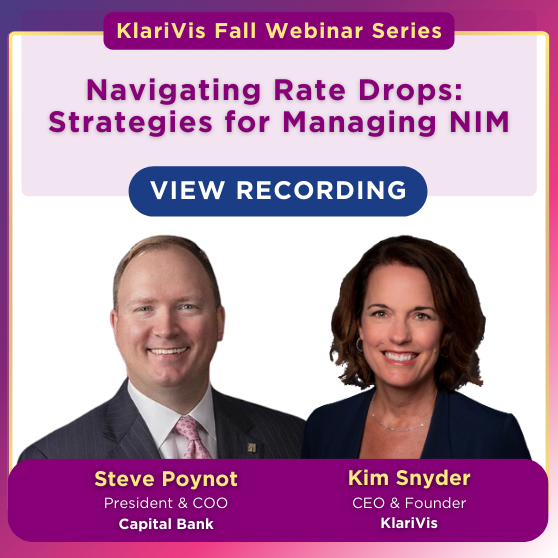The browser you are using is not supported. Please consider using a modern browser.
Article
How to Protect Your Community Bank’s NIM when the Economy Won’t Cooperate
We all know that today’s interest rate environment is unpredictable, to say the least. Managing Net Interest Margin (NIM) has always been a juggling act, but now it feels like the stakes are higher, and the leeway is tighter. Interest rates are dropping, competition is fierce, and yet somehow, you’re expected to keep your margins healthy and your profitability in check. Easy, right?
In a recent KlariVis webinar, Steve Poynot, President & COO of Capital Bank, and Kim Snyder, CEO & Founder of KlariVis, provided attendees with straightforward strategies on how to survive—and even thrive—in this environment. Here’s a recap of their best advice, no fluff—just actionable ideas for smart bankers.
1. Spot Errors Early: Protect Your Margin
Nobody’s perfect, and mistakes happen. But when it comes to loan and deposit pricing, small errors can add up to big losses if they go unnoticed. Steve Poynot shared a simple yet critical truth: pay attention. Keeping an eye on real-time data is key to spotting these mistakes before they hurt your bottom line.
Imagine discovering you’ve been underpricing a loan for weeks. Ouch. That’s real money flying out the door. The solution? Use a system that lets you monitor rate changes and catch errors in real-time.
Actionable Insight: Equip your bank with real-time data tools to monitor daily activity and track anomalies. Don’t wait for month-end reports – staying on top of daily data leads to early detection of rate errors that can significantly improve operational efficiency and protect NIM. It’s always better to fix small issues before they become expensive headaches.
2. Stop Reacting. Start Proacting (Yes, That’s a Word Now)
We all know that reacting to market changes feels like the safe move. But waiting until after rates shift means you’re already a step behind. Steve and Kim emphasized the importance of proactive management. Look at your numbers daily, not just at the end of the month. This isn’t just for the sake of it—it’s so you can adjust your strategy based on what’s happening now.
By regularly reviewing your pricing on both loans and deposits, you can make small tweaks that protect your margins before you’re forced to react to bigger changes.
Actionable Insight: Don’t wait for the next rate adjustment. Proactively review loan and deposit pricing on a daily basis and adjust your strategy based on real-time data to keep your bank’s NIM stable.
3. Give Your Team the Tools—and Hold Them Accountable
Your team is only as good as the tools you give them. When your team has access to real-time insights, they aren’t just reacting to change—they’re driving it. That’s where the real competitive advantage lies.
Capital Bank made a cultural shift by giving their employees direct access to daily data. Why? Because it gives them the power to make better decisions. When they (and everyone else) can see their performance in real-time, they’re more likely to adjust on the fly and stay on top of their goals.
Actionable Insight: Invest in tools that allow your staff to access real-time data. This not only fosters accountability but also gives your team the insights needed to make informed decisions that positively affect NIM.
4. Know Your Customers Better with Transactional Data
Community banks pride themselves on “knowing their customers.” But do you, really? Steve shared how Capital Bank tracks the flow of funds within customer accounts to understand how their clients move money, invest, and manage liquidity. By analyzing this transactional data, you can spot gaps in relationships and identify areas where you can offer more services.
The key here is using data to have more meaningful conversations with customers. If you can show that you know where their money is going—and why—you can also show them why it makes sense to bring more of their business to your bank.
Actionable Insight: Leverage transactional data to understand your customers’ needs and behaviors. This allows you to offer personalized services and strengthen relationships, ultimately leading to more deposits and lending opportunities.
5. Build a Culture Where Performance Actually Matters
Let’s be real: volume alone doesn’t cut it. Booking loans feels good, but if the profitability isn’t there, what’s the point? At Capital Bank, the focus isn’t just on booking loans—it’s about profitability and NIM. When lenders can see how they stack up against each other on both volume and performance, it sparks competition.
Suddenly, everyone’s working smarter, not just harder. And that’s what builds a true performance culture—one where numbers mean something.
Actionable Insight: Create a performance-driven culture by sharing transparent metrics with your team. This fosters competition, improves performance, and leads to better NIM outcomes.
6. Plan for the What-Ifs
You can’t predict exactly what’s going to happen with rates—whether they’re going up, down, or staying the same. But what you can do is plan for different scenarios. Both Steve and Kim stressed the importance of having multiple strategies in place, depending on where rates move next.
Rather than reacting when rates change, prepare now (see Tip #2). Have a plan for rising rates, another for falling rates, and a third for when they hold steady. That way, when the next move happens, you’re ready to act.
Actionable Insight: Develop multiple scenarios in your forecasting models. Be ready to execute different strategies depending on how interest rates and market conditions evolve. You can’t predict the future, but you can prepare for it.
Take Charge and Make Data Work for You
In a market that’s constantly shifting, waiting for stability isn’t going to cut it. Community banks have the opportunity to take control by focusing on what they can manage: real-time data, daily adjustments, and empowering their teams to make smart decisions. By being proactive and planning for multiple scenarios, you can protect your NIM and keep your bank profitable, no matter what happens next.
Don’t just watch from the sidelines—take charge, and keep your bank moving forward.


